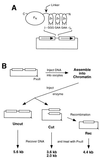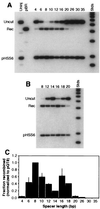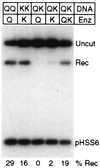Stimulation of homologous recombination through targeted cleavage by chimeric nucleases
- PMID: 11113203
- PMCID: PMC88802
- DOI: 10.1128/MCB.21.1.289-297.2001
Stimulation of homologous recombination through targeted cleavage by chimeric nucleases
Abstract
Chimeric nucleases that are hybrids between a nonspecific DNA cleavage domain and a zinc finger DNA recognition domain were tested for their ability to find and cleave their target sites in living cells. Both engineered DNA substrates and the nucleases were injected into Xenopus laevis oocyte nuclei, in which DNA cleavage and subsequent homologous recombination were observed. Specific cleavage required two inverted copies of the zinc finger recognition site in close proximity, reflecting the need for dimerization of the cleavage domain. Cleaved DNA molecules were activated for homologous recombination; in optimum conditions, essentially 100% of the substrate recombined, even though the DNA was assembled into chromatin. The original nuclease has an 18-amino-acid linker between the zinc finger and cleavage domains, and this enzyme cleaved in oocytes at paired sites separated by spacers in the range of 6 to 18 bp, with a rather sharp optimum at 8 bp. By shortening the linker, we found that the range of effective site separations could be narrowed significantly. With no intentional linker between the binding and cleavage domains, only binding sites exactly 6 bp apart supported efficient cleavage in oocytes. We also showed that two chimeric enzymes with different binding specificities could collaborate to stimulate recombination when their individual sites were appropriately placed. Because the recognition specificity of zinc fingers can be altered experimentally, this approach holds great promise for inducing targeted recombination in a variety of organisms.
Figures







Similar articles
-
Requirements for double-strand cleavage by chimeric restriction enzymes with zinc finger DNA-recognition domains.Nucleic Acids Res. 2000 Sep 1;28(17):3361-9. doi: 10.1093/nar/28.17.3361. Nucleic Acids Res. 2000. PMID: 10954606 Free PMC article.
-
Chimeric nucleases stimulate gene targeting in human cells.Science. 2003 May 2;300(5620):763. doi: 10.1126/science.1078395. Science. 2003. PMID: 12730593 No abstract available.
-
High-frequency homologous recombination in plants mediated by zinc-finger nucleases.Plant J. 2005 Nov;44(4):693-705. doi: 10.1111/j.1365-313X.2005.02551.x. Plant J. 2005. PMID: 16262717
-
Chimeric restriction enzymes: what is next?Biol Chem. 1999 Jul-Aug;380(7-8):841-8. doi: 10.1515/BC.1999.103. Biol Chem. 1999. PMID: 10494832 Free PMC article. Review.
-
[Zinc finger nucleases and their application].Zhonghua Yi Xue Yi Chuan Xue Za Zhi. 2010 Apr;27(2):162-5. doi: 10.3760/cma.j.issn.1003-9406.2010.02.010. Zhonghua Yi Xue Yi Chuan Xue Za Zhi. 2010. PMID: 20376797 Review. Chinese.
Cited by
-
Customizing the genome as therapy for the β-hemoglobinopathies.Blood. 2016 May 26;127(21):2536-45. doi: 10.1182/blood-2016-01-678128. Epub 2016 Apr 6. Blood. 2016. PMID: 27053533 Free PMC article. Review.
-
Gene Editing and Human iPSCs in Cardiovascular and Metabolic Diseases.Adv Exp Med Biol. 2023;1396:275-298. doi: 10.1007/978-981-19-5642-3_18. Adv Exp Med Biol. 2023. PMID: 36454473
-
Human-induced pluripotent stem cells: in quest of clinical applications.Mol Biotechnol. 2012 Oct;52(2):193-203. doi: 10.1007/s12033-012-9504-0. Mol Biotechnol. 2012. PMID: 22302314 Review.
-
Targeting G with TAL effectors: a comparison of activities of TALENs constructed with NN and NK repeat variable di-residues.PLoS One. 2012;7(9):e45383. doi: 10.1371/journal.pone.0045383. Epub 2012 Sep 24. PLoS One. 2012. PMID: 23028976 Free PMC article.
-
Advances in targeted genome editing.Curr Opin Chem Biol. 2012 Aug;16(3-4):268-77. doi: 10.1016/j.cbpa.2012.06.007. Epub 2012 Jul 20. Curr Opin Chem Biol. 2012. PMID: 22819644 Free PMC article. Review.
References
-
- Capecchi M R. Altering the genome by homologous recombination. Science. 1989;244:1288–1292. - PubMed
-
- Carroll D. DNA recombination and repair in Xenopus oocytes and eggs: substrate design, direct microinjection, and extract preparation. In: Richter J D, editor. A comparative methods approach to the study of oocytes and embryos. New York, N.Y: Oxford University Press; 1999. pp. 173–195.
-
- Carroll D. Homologous genetic recombination in Xenopus: mechanism and implications for gene manipulation. Prog Nucleic Acid Res Mol Biol. 1996;54:101–125. - PubMed
Publication types
MeSH terms
Substances
Grants and funding
LinkOut - more resources
Full Text Sources
Other Literature Sources
Research Materials
